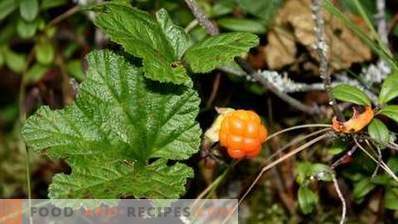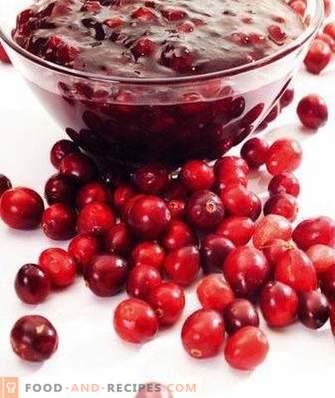
Residents of the southern regions do not even realize that there are no fewer berries in the northern part of the hemisphere than theirs. And maybe more.
Even such seemingly unsuitable places for living as swamps and tundra are rich in useful vegetation and delicious fragrant berries.
In the neighborhood of blueberries, blueberries, lingonberries, cloudberries that do not stand out due to their size grow.
Despite its bright national name - “royal berry”, “northern orange”, “arctic raspberry”, it is a short, three-leafed herb and a upright stalk, at the top of which a single berry proudly sits, resembling a raspberry or an unripe blackberry And I can not even believe that this small berry 1-1, 5 cm in diameter - a storehouse of nutrients and healing properties.
Useful properties of cloudberries
- Cloudberries are rich in proteins, sugar, fiber, malic and citric acid.
- In cloudberries there are vitamins C, B1, B2, A, E, P, as well as trace elements: potassium, phosphorus, iron, cobalt ...
- Berries are rich in tannins, so they are recommended for diarrhea.
- Cloudberry has an anti-inflammatory and diuretic effect, therefore it is successfully used in the treatment of colds, coughs, inflammation of the bladder, and cystitis.
- Cloudberry tincture helps with metabolic disorders.
- Juice of berries treats skin diseases and even scabies.
- Vitamin-rich berries are recommended for anemia, scurvy, malaria.
- Cloudberry extract is a good prophylactic agent for cancer.
- Cloudberry strengthens the immune system.
- The leaves have a hemostatic effect.
- Cloudberries are added to cosmetic creams.
How and when to collect cloudberries
Cloudberries begin to bloom in May, but the fruits appear only after a month and a half - in July or in August.
- At first the berries are light green, almost white, then they turn red. People who do not know the degree of maturity of cloudberries think that it is time to go for the berries. But this berry has not ripened yet. Fully ripe orange berry, poured with juice so that it even seems as if it glows from the inside, and the bones appear through the skin.
- Berry picking is not an easy task. It happens that you need to go a decent distance through the marshland to find a plot with cloudberry thickets.
- For picking berries, one cannot choose places near industrial enterprises or in ecologically polluted areas.
- Gather berries in the morning or evening, be sure to choose dry weather.
- Since cloudberries are a juicy berry, it is better to use cans or low buckets to collect them. Cloudberries do not grow in clusters or clusters, so to gain a full bucket, you need to spend more than one hour. Indeed, in the process of filling the container, the berries settle, making room for a new party.
- It is important not to miss the time when the berries ripen, as picking cloudberries lasts only two weeks, and then the berry overrides and is no longer suitable for cooking - when it is pulled from the sprig it just spreads in the hands, turning into puree. Therefore, the optimal time for picking berries is when they changed the red color to red and yellow.
- They break berries together with sepals, which are then cut off and used for drying for medicinal purposes. Experts advise to collect cloudberries for workpieces for future use on a waning moon. But if the berries are needed for eating in the near future, then the trip for them is better to organize on the growing moon.
- When carrying berries to the destination, buckets or cans should be covered with grass, burdocks or a clean cotton cloth from the sun's rays, but by no means polyethylene film.
- Cloudberries are stored very poorly, especially overripe. After a few hours, it turns into a mash. The locals, knowing her such a feature, adapted themselves before picking the berries to cook sugar syrup, in which this berry was immediately dropped upon arrival home. But compote harvested slightly unripe berry.
- Since the berries grow in the marshland, it is imperative to stock up on mosquitoes and mosquitoes, which can ruin the joy of communicating with nature.
You also need to know about contraindications that exist when using this berry.
- Due to the large amount of acids, cloudberries cannot be eaten by people with high acidity of the stomach.
- With peptic ulcer and gastritis.
- With individual intolerance.











































